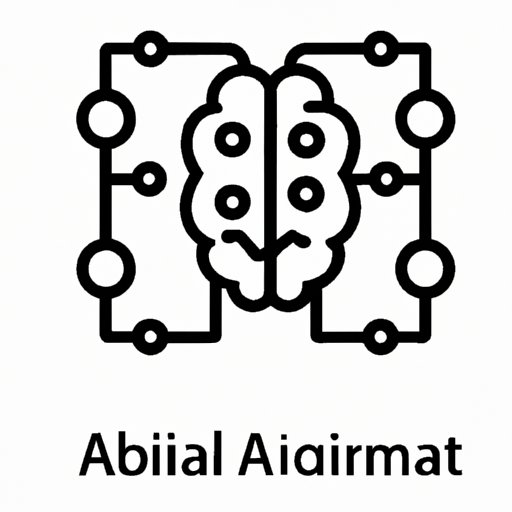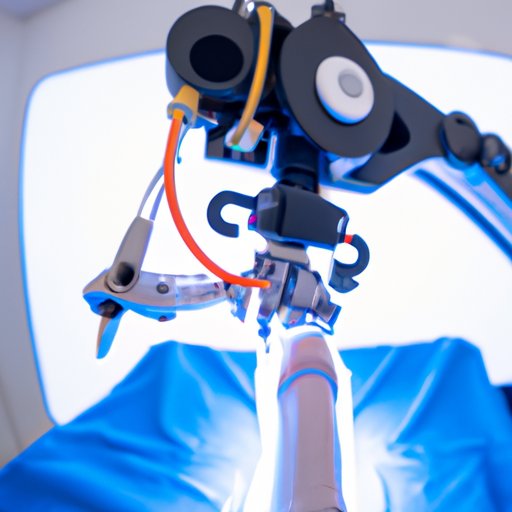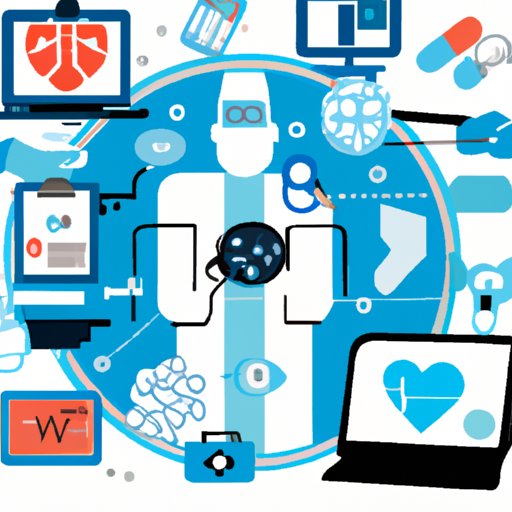Introduction
Technology has revolutionized many aspects of our lives, and healthcare is no exception. Technology has had a profound impact on healthcare, transforming patient care and quality of care, improving accessibility to healthcare services, enhancing self-monitoring and preventive care, revolutionizing clinical research and outcomes analysis, and reducing invasive surgical procedures. In this article, we will explore how technology has improved healthcare, including the benefits and challenges associated with it.
Electronic Medical Records: Impact on Patient Care and Quality of Care
Electronic medical records (EMRs) are digital versions of paper-based medical records. They enable healthcare providers to store and access patient information quickly and accurately. By improving the speed and accuracy of communication between healthcare providers and patients, EMRs have had a positive effect on patient care and quality of care.
Benefits of Electronic Medical Records
The use of EMRs has numerous benefits. First, EMRs allow for more efficient and accurate record keeping. With EMRs, healthcare providers can access patient information quickly and accurately, enabling them to provide better care. Additionally, EMRs make it easier to share information between healthcare providers, allowing for better coordination and continuity of care. Finally, EMRs provide a more secure way of storing patient information, as they are protected by various levels of encryption and security protocols.
Challenges of Electronic Medical Records
Despite the many benefits of EMRs, there are also challenges associated with their use. One challenge is the cost of implementation and maintenance. Additionally, there are issues related to privacy and security, as well as compatibility between different systems. Finally, EMRs require training and ongoing education for healthcare providers to use them effectively.

Telehealth: Improving Accessibility to Healthcare Services
Telehealth is the use of technology to deliver remote health services. It includes a wide range of technologies such as video conferencing, phone calls, and mobile apps, which enable healthcare providers to connect with patients remotely. Telehealth has been shown to improve access to healthcare services, particularly for individuals who live in rural or underserved areas.
Benefits of Telehealth
The use of telehealth has numerous benefits. First, it improves access to healthcare services, as individuals living in rural or underserved areas can access healthcare services without having to travel long distances. Additionally, it reduces healthcare costs, as it eliminates the need for in-person visits. Finally, it enables healthcare providers to monitor patients remotely, allowing for better management of chronic conditions.
Challenges of Telehealth
Despite the many benefits of telehealth, there are also challenges associated with its use. One challenge is ensuring the security and privacy of patient data. Additionally, there are technological issues related to connectivity and bandwidth. Finally, telehealth requires additional training and resources for healthcare providers to use it effectively.
Wearable Technology: Enhancing Self-Monitoring and Preventive Care
Wearable technology, such as fitness trackers and smart watches, has become increasingly popular in recent years. This type of technology allows individuals to easily track their physical activity, diet, and sleep patterns, enabling them to better manage their health and wellbeing.
Benefits of Wearable Technology
The use of wearable technology has numerous benefits. First, it allows individuals to track their health and wellbeing in real-time, enabling them to take proactive steps towards improving their health. Additionally, it provides healthcare providers with valuable data that can be used to identify trends and potential health risks. Finally, wearable technology can be used to remind individuals to take medications or complete other tasks related to their health.
Challenges of Wearable Technology
Despite the many benefits of wearable technology, there are also challenges associated with its use. One challenge is ensuring the accuracy of the data collected. Additionally, there are privacy and security concerns related to the data collected by these devices. Finally, the cost of purchasing and maintaining wearable technology can be prohibitive for some individuals.

Artificial Intelligence in Diagnostics and Treatment Planning
Artificial intelligence (AI) is a rapidly growing field in healthcare. AI is being used to develop tools that can analyze large amounts of data to diagnose diseases and develop personalized treatment plans. AI has the potential to revolutionize healthcare by providing more accurate diagnoses and treatments.
Benefits of Artificial Intelligence
The use of AI has numerous benefits. First, it can analyze large amounts of data quickly and accurately, allowing healthcare providers to make better informed decisions. Additionally, AI can be used to develop personalized treatment plans based on an individual’s unique circumstances. Finally, AI can be used to identify trends in healthcare data, enabling healthcare providers to identify and address potential health risks.
Challenges of Artificial Intelligence
Despite the many benefits of AI, there are also challenges associated with its use. One challenge is ensuring the accuracy of the data analysis. Additionally, there are ethical concerns related to the use of AI in healthcare, such as the potential for bias in decision-making. Finally, AI requires significant investments in infrastructure and resources to be effective.

Robotics: Reducing Invasive Surgical Procedures
Robotic surgery is an increasingly popular form of minimally invasive surgery. Robotic surgery involves the use of robotic arms to perform precise, complex surgical procedures with minimal risk. This type of surgery has been shown to reduce recovery time, reduce scarring, and decrease the risk of complications.
Benefits of Robotics
The use of robotics in surgery has numerous benefits. First, it allows surgeons to perform complex surgical procedures with greater precision and accuracy. Additionally, it reduces the risk of complications, as the robotic arms are able to operate with greater accuracy than human hands. Finally, robotic surgery can reduce recovery time and reduce the need for post-operative care.
Challenges of Robotics
Despite the many benefits of robotic surgery, there are also challenges associated with its use. One challenge is the cost of purchasing and maintaining the equipment. Additionally, there are safety concerns related to the use of robotic surgery, as there is always the risk of malfunction or error. Finally, robotic surgery requires specialized training and ongoing education for surgeons to use it effectively.
Big Data: Revolutionizing Clinical Research and Outcomes Analysis
Big data is a term used to describe large sets of data that can be analyzed to uncover insights and trends. In healthcare, big data is being used to revolutionize clinical research and outcomes analysis. By combining patient data with other sources of data, healthcare providers can gain valuable insights into disease processes and patient outcomes.
Benefits of Big Data
The use of big data has numerous benefits. First, it allows healthcare providers to gain valuable insights into disease processes and patient outcomes. Additionally, it allows healthcare providers to identify and address potential health risks before they become serious problems. Finally, it enables healthcare providers to develop more efficient and effective treatments.
Challenges of Big Data
Despite the many benefits of big data, there are also challenges associated with its use. One challenge is ensuring the accuracy of the data analysis. Additionally, there are privacy and security concerns related to the collection and storage of large amounts of data. Finally, big data requires significant investments in infrastructure and resources to be effective.
Conclusion
In conclusion, technology has had a profound impact on healthcare, transforming patient care and quality of care, improving accessibility to healthcare services, enhancing self-monitoring and preventive care, revolutionizing clinical research and outcomes analysis, and reducing invasive surgical procedures. The use of technology in healthcare has both benefits and challenges, but overall, it has improved healthcare significantly.
(Note: Is this article not meeting your expectations? Do you have knowledge or insights to share? Unlock new opportunities and expand your reach by joining our authors team. Click Registration to join us and share your expertise with our readers.)
